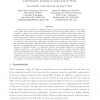Free Online Productivity Tools
i2Speak
i2Symbol
i2OCR
iTex2Img
iWeb2Print
iWeb2Shot
i2Type
iPdf2Split
iPdf2Merge
i2Bopomofo
i2Arabic
i2Style
i2Image
i2PDF
iLatex2Rtf
Sci2ools
SIGCOMM
1999
ACM
1999
ACM
Load-Sensitive Routing of Long-Lived IP Flows
Internet service providers face a daunting challenge in provisioning network resources, due to the rapid growth of the Internet and wide fluctuations in the underlying traffic patterns. The ability of dynamic routing to circumvent congested links and improve application performance makes it a valuable traffic engineering tool. However, deployment of load-sensitive routing is hampered by the overheads imposed by link-state update propagation, path selection, and signaling. Under reasonable protocol and computational overheads, traditional approaches to load-sensitive routing of IP traffic are ineffective, and can introduce significant route flapping, since paths are selected based on out-ofdate link-state information. Although stability is improved by performing load-sensitive routing at the flow level, flapping still occurs, because most IP flows have a short duration relative to the desired frequency of link-state updates. To address the efficiency and stability challenges of ...
| Added | 03 Aug 2010 |
| Updated | 03 Aug 2010 |
| Type | Conference |
| Year | 1999 |
| Where | SIGCOMM |
| Authors | Anees Shaikh, Jennifer Rexford, Kang G. Shin |
Comments (0)

